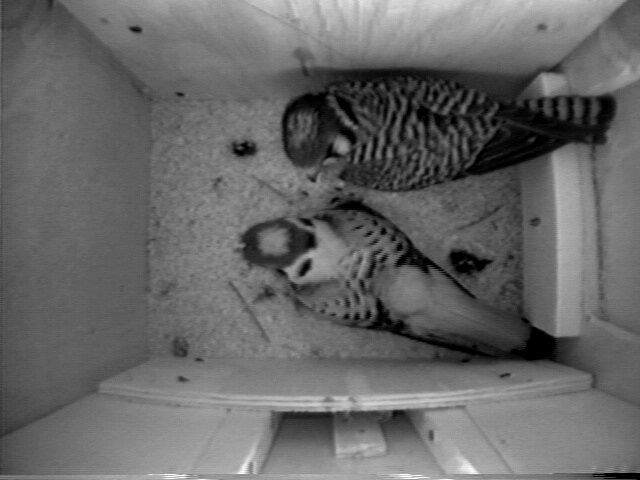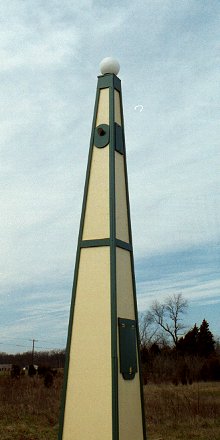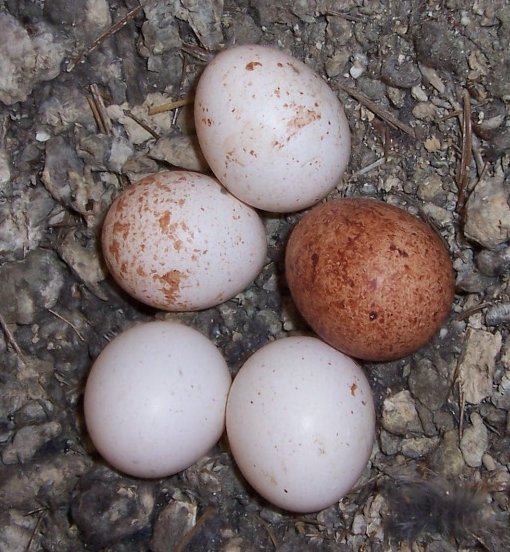
Richard and Diane Van Vleck Personal Pages The Home Habitat |
 The new kestrel tower in our extended front yard is the site of this year's kestrel video. Four of the five eggs hatched on May 8. The young are doing great as of today (6/2), and prey seems to be as abundant as in previous years. Twice so far a nestling has managed to squirt excrement all the way up to the camera lens at the top of the box. This also happened once last year when the nestlings were about the same age. They seem to develop adequate power before adequate aim. The purpose of their ejecting excreta high on the walls of the nest box is to keep the bottom of the nest and themselves clean.
The new kestrel tower in our extended front yard is the site of this year's kestrel video. Four of the five eggs hatched on May 8. The young are doing great as of today (6/2), and prey seems to be as abundant as in previous years. Twice so far a nestling has managed to squirt excrement all the way up to the camera lens at the top of the box. This also happened once last year when the nestlings were about the same age. They seem to develop adequate power before adequate aim. The purpose of their ejecting excreta high on the walls of the nest box is to keep the bottom of the nest and themselves clean.
All four nestlings are male. Kestrel broods are often biased toward males when conditions are less than ideal. Perhaps, the 5th egg, which didn't hatch would have been the female. The ratio last year was 4 to 1.

The adults behaved quite differently on my rare visits to the tower to change the videotapes and monitor the min/max thermometer. As I approached, I always talked to them to let them know I was coming. The female would always instantly leave the nest and fly off when she heard me. When the male was incubating, he always stayed at the nest and would not even flinch when I made a noise or opened the equipment compartment door. While watching him on the video monitor in the tower, my tapping on the wall would barely elicit a response. Twice when I had to put a ladder on the tower and climb up to open the nestbox door to clean the camera lens, the female would dive bomb me, once giving me a hard rap on the head. The old box on the barn wall with its back door opening to the inside of the barn allowed me to hide my visits from the adults and we got along much better. I could go up in the barn and play with the babies whenever I wanted without the adults knowing. But after seeing me climb the tower, they treat me more like a lowly raccoon than like their great benefactor.
Aug 3, 2004 update The tower kestrels fledged 5 young in 2003 and 10 in 2004. This was the first year that two broods were raised, with the second brood leaving the tower July 22, the same day that the last of the bluebirds fledged from the front yard box. No conflict there - the young kestrels perch on the phone line, a board fence, and even the upstairs porch railing, begging the parents for food, while the bluebirds are off to a wilder area 300 yards from the tower. Our bluebirds do just fine in the taller grass, poison ivy, and other vegetation interspersed with clumps of cedar, sumac, locust, and other volunteer species. Bluebirds certainly don't require lawn, as is sometimes stated.
No continuous video was recorded at the tower nestings in 2003 or 2004. I would take out a small tv monitor and plug it into the permanently mounted camera to check on the nesting progress every week or so, but, for the most part, left them alone. A project for a future year will be a prey study, using two more cameras and the quad splitter. This year, my limited time for doing video was confined to the bats, a preliminary barn swallow feeding study, and two new cavity nesting species, the Carolina wren, nesting on one of my tractors, and a gray squirrel nesting in a screech owl box.
The following still photos are taken from a single frame of video from the 6 hr vhs tapes. This process results in a substantial loss of quality compared to the original camera image and vhs tape. However, the rapid development of the nestlings is apparent in this series.

April 7, 2005 update Again this year, I'm not recording the kestrel nesting, but, rather, taking a small tv out to the tower every couple weeks to connect to the camera and check the nesting progress. Today, all five eggs were present and the female was incubating. I also climbed up to clean the camera lens and check why one egg looked so dark in the monochrome tv image. Kestrels don't like this! The female continuously dive bombed me as I was unscrewing the access door bolts. Luckily, I could see her shadow on the ground, off to the east in the late afternoon sun. After she gave me several sound raps on the head, I learned to watch for her shadow approaching and throw up my arm at the last moment. This caused her to veer off each time. My experience has been that kestrels don't dig in those formidible talons and do any damage - they simply hit and run. It's surprising how hard they can hit, given their body weight.
 The egg pigmentation was extremely varied. It would have been interesting to see if the eggs were laid in random order or if they progressed from less to more pigmentation or vice versa. Their diet seems to consist almost entirely of meadow voles this time of year.
The egg pigmentation was extremely varied. It would have been interesting to see if the eggs were laid in random order or if they progressed from less to more pigmentation or vice versa. Their diet seems to consist almost entirely of meadow voles this time of year.
July 20, 2005 Four young fledged from the first brood of 2005 and now the kestrels are incubating 2 eggs of a second brood. I think this is the full clutch and have been incubated for awhile, although this is the first day I checked the nest in a couple months. The 1st brood fledglings have dispersed, the last leaving a week ago. This brood made more of a mess on the camera than any previous broods, although, I used to clean the cam frequently when the nesting was being taped.
It would be interesting to see what prey is brought to these two nestlings (now eggs) in late summer. If all goes well, I may tape the nesting when a vcr is freed up after the last purple martins fledge.
the overhead kestrel cam - a target for fecal bombardment
The two eggs of a second brood, July 20, 2005
Dec 11, 2006 This year the kestrels once again had two broods. Video equipment was not installed in the tower, since the polygamous barn owl nesting demanded all of our attention. Five young fledged from the first brood and at least three from the second. Now, in December, the male kestrel has once again taken to roosting under the barn eaves, as he has done for several winters. Luckily, he shows no interest in the barn yard during the martin nesting season.
kestrel roost whitewash on the barn
| barn owl | American kestrel | purple martin | barn swallow | Eastern bluebird |
| tufted titmouse | Eastern phoebe | yellow shafted flicker | tree swallow | chimney swift |
| house wren | big brown bat | Carolina wren | brown thrasher | catbird |
| cedar waxwing | Northern mockingbird | |||
| Yellow warbler | Acadian flycatcher | |||
email richard@americanartifacts.com
© 2002 - 2013, American Artifacts and Richard Van Vleck, Taneytown, Maryland.